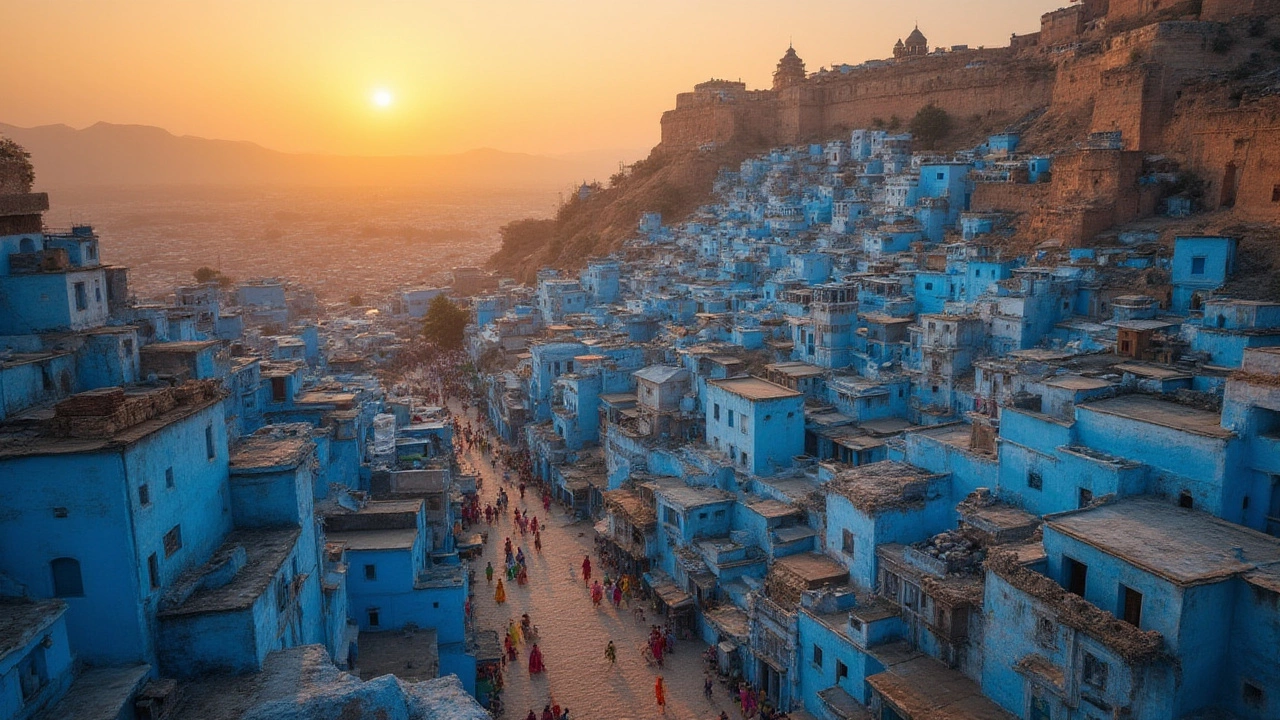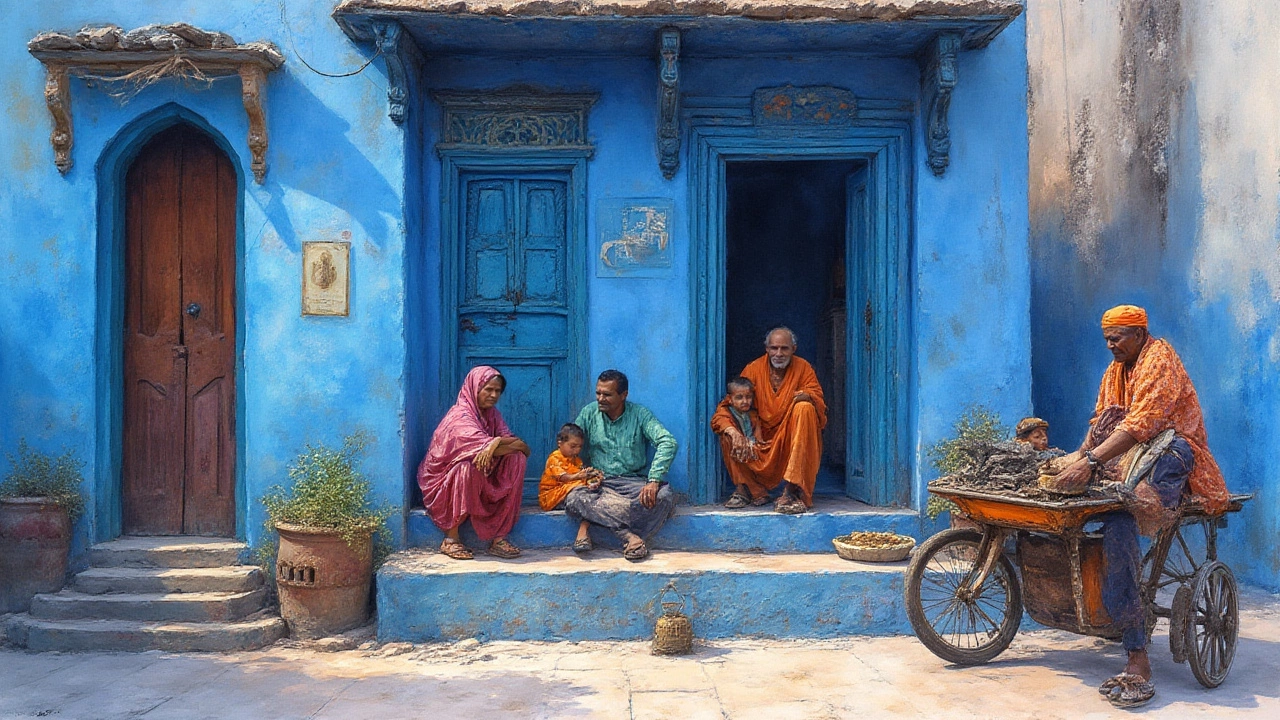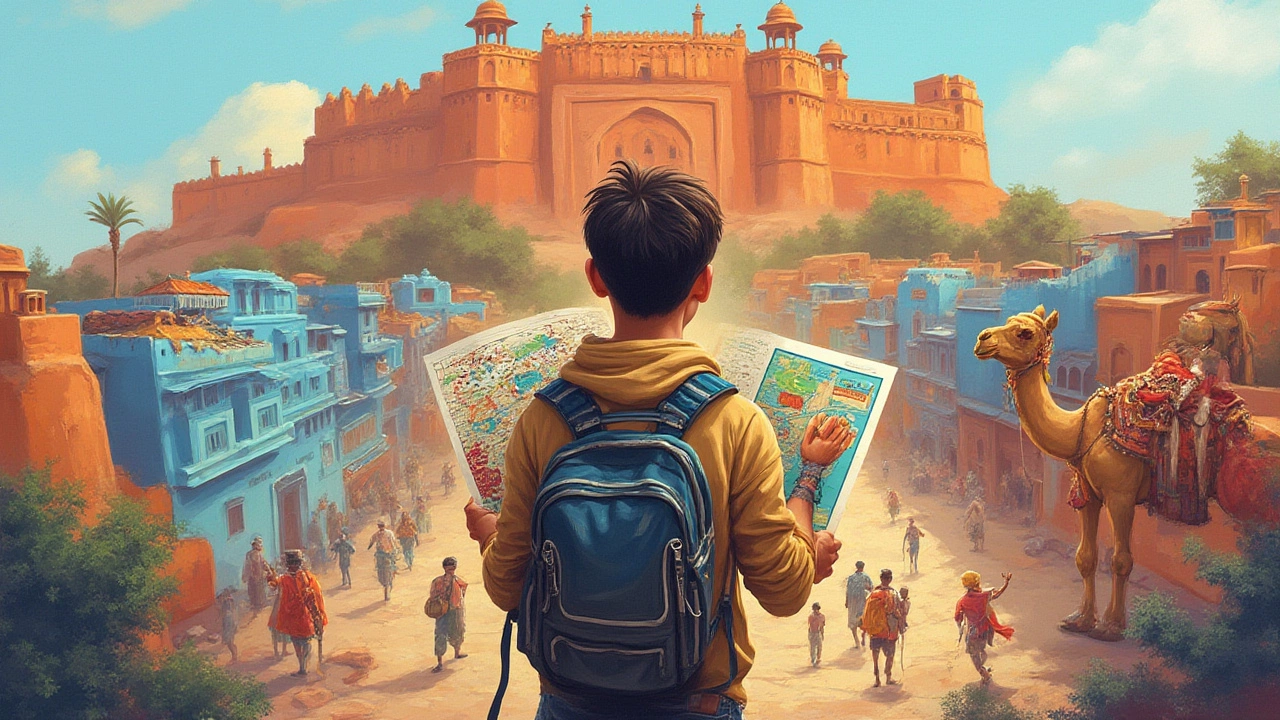Why Jodhpur is Known as the Blue City of India: History, Culture, and Travel Tips
 Jul, 20 2025
Jul, 20 2025
Ever seen a city so blue that it looks like it’s wearing the sky? There’s a city in India where the walls, houses, and streets all come together in a surreal patchwork of indigo and turquoise. Most folks call it Jodhpur, but anyone who’s been there knows its other name: the Blue City. That sea of blue isn’t just great for Instagram—it’s packed with history, legends, and mysteries. This isn’t a storybook scene or a Photoshop trick. Jodhpur is real, it’s loud, it smells of spices and has streets echoing with laughter and honking auto-rickshaws. And it’s all blue, for a reason.
The Origin of the Blue City: Fact or Legend?
So, why did Jodhpur go blue in the first place? The short answer: no one can say for sure. But there’s plenty of theories, and each one feels like you’re peeling back a new layer of the city’s personality. The most common story? Centuries ago, when the Brahmins—India’s traditional priestly caste—made the city home, they began painting their houses blue. Some say it helped set the Brahmin homes apart from others. But over time, non-Brahmins joined in. Maybe it was contagious, or maybe everyone liked the look. You know how trends start; someone does something cool, and neighbors follow.
There’s another practical explanation, though: the blue limewash was believed to repel heat and keep termites away. In Rajasthan’s scalding summers, anything to cut the heat is a clever move. The city sits on the edge of the Thar Desert, and summertime here is no joke. The blue reflects the sunlight, creating surprisingly cooler interiors. Locals will swear it makes a difference. Some even believe the indigo pigment wards off evil—which, in a city as old as Jodhpur, probably felt important back when superstitions ran deep.
Whatever the real reason, this patchwork of blue caught on and stuck around. Walk through the old city’s winding lanes and you’ll see the color everywhere—from century-old havelis to crumbling boundary walls. Some homes are so blue, even the plants out front seem tinted. Here’s a tip—if you want to see the maximum blue, head for the quarter around the Mehrangarh Fort. Trust me, the view from up there justifies the climb.
Life Inside the Blue Walls: Culture, People, and Everyday Moments
The Blue City is more than just a paint job; it shapes how people live, work, and celebrate. Life moves at its own, rather unpredictable, pace in these blue lanes. You’ll wake up to temple bells, street vendors shouting out their wares, and the smell of fresh chai. Sometimes goats wander through the alleyways, totally unfazed by the scooters whizzing past.
Family is everything here. Most houses are packed with generations living under one blue roof. And if a festival is on, get ready for the music, colors, and flower petals to spill right onto the street. Diwali is a riot of lights reflecting off blue walls, and Holi—the famous festival of colors—makes the city even more vibrant, if that’s possible. Locals are proud of their heritage and are usually more than happy to talk about the city’s quirks or share tips about hidden corners.
Don’t skip the markets. Sardar Market, near the iconic Clock Tower, is chaotic in the best way. You’ll find vendors selling everything from spices to bangles, saris, and antiques. There’s also a huge tradition of blue pottery here—check out some of the shops run by the same families for generations. Stop by a street-side eatery and try a plate of mirchi bada or some piping hot samosas. If you’re lucky, someone will insist you join them for homemade dal baati churma. Don’t say no—hospitality is serious business in Jodhpur.
Another thing—music pulses through this city. Folk musicians play the sarangi and dholak, and you might catch a performance under the shadow of an old archway. There’s often a wedding somewhere, and you’ll see people dressed in outrageous colors, adding to the city’s visual feast.

Exploring the Blue City: Key Sites and Best Views
It’s impossible to talk about Jodhpur without mentioning Mehrangarh Fort. It rises like a movie set above the old city, and from its walls, you get that famous view—rooftops stretching to the horizon in every shade of blue. The fort itself is massive, with winding corridors, hidden passageways, and museums showing off swords, palanquins, and royal costumes.
Want a panoramic shot? Get to the ramparts about an hour before sunset. The sunlight hits the blue houses just right, and the whole city glows. Photographers drool over this scene. If you’re feeling adventurous, you can even zipline from the fort—yes, zipline—over ancient battlements and the city below.
The old city is where the magic happens. Walk the maze of streets near the Navchokiya or Brahmpuri area for the most intense blue. These narrow, twisting alleys are lined with doors and windows painted in indigo, giving the whole area a slightly dreamlike feel. Don’t be surprised if local kids run up wanting to practice their English, or if you bump into cows sleeping right in the middle of the way.
Umaid Bhawan Palace—the city’s other crown jewel—is a taste of 20th-century luxury. Part hotel, part royal residence, part museum, it’s worth a visit even if you can’t afford to stay overnight. Gaze at the art deco decor, stroll the gardens, and check out the collection of vintage cars. And, while it’s not blue, the palace adds layers to the city’s story.
If you love temples, Mahamandir and Jaswant Thada are must-sees. Jaswant Thada, especially, is a calm spot—its white marble stands out against the blue city and offers a quiet place to take it all in.
Tips for Travelers: When to Visit, What to Eat, and How to Get Around
The best time to visit Jodhpur? October to March, hands down. This is when the heat backs off, nighttime gets pleasantly chilly, and you can actually enjoy walking around. The city throws several big festivals during this window, like the Rajasthan International Folk Festival in October and the Marwar Festival.
Pack light, breathable clothes, but bring a light jacket if you’re visiting between December and January—desert nights can surprise you. Good walking shoes are a must. The old city is all about exploring on foot, but be prepared for dusty streets, uneven steps, and the occasional friendly street dog or cow. Auto-rickshaws are everywhere and cheap, just be ready to haggle.
You’ll want to try the food—trust me on this. The city loves its spices. Don’t miss laal maas (spicy red mutton curry), mirchi bada (chili fritters), or ghevar (a sweet treat you’ll dream about later). For drinks, tie a breezy scarf around your head and sip on makhaniya lassi—thick and creamy, it’s the city’s secret weapon against the heat.
Don’t stay glued to your phone’s map. The streets are wild but safe, and some of the best blue corners are found by accident, not design. Get lost a little—that’s part of the fun here. Jodhpur gets plenty of tourists, but step off the beaten track and you’ll find peaceful courtyards, quirky wall art, or a shy peacock perched on a blue ledge.
Buying souvenirs? Go for handicrafts like block-printed fabrics, silver jewelry, and especially the iconic blue pottery. Just make sure you’re buying from a reputable place—don’t be shy about asking locals for pointers. Bargaining is expected. Start low, and meet the seller halfway with a smile.
Want to take the vibe home? Spend a night at a homestay in the old city. Hosts love sharing local secrets, and you’ll wake up to the real sounds of Jodhpur, not just filtered tourist experiences.

The Blue City in a Modern World: Tradition Meets Trend
Jodhpur is always shifting. The blue lanes aren’t frozen in time—kids with smartphones hang out where their grandparents stored hand-painted pots. New art cafés pop up next to 200-year-old temples. Young entrepreneurs are turning ancestral homes into boutique guesthouses, showing off mosaics and painted ceilings you’d miss if you stuck to the main roads.
The city’s popularity with international travelers isn’t just about its looks. Jodhpur’s got a certain swagger, a confidence you only get when 500 years of history are mixed with a hot sun and a proud community. People come for the color and stay for the stories and the unexpected kindness of strangers offering you chai.
There’s some challenges too. The paint needs regular touch-ups—sun and monsoon weather don’t play nice. But there’s a new wave of restoration underway. NGOs and locals are pitching in to keep the city’s identity alive, fixing walls, opening up heritage walks, and teaching the next generation about why these blue streets matter.
If there’s one thing to take away, it’s this: the Blue City of India isn’t just a nickname. It’s a living canvas, a maze of old and new, and a place where every shade of blue tells a human story. So, put Jodhpur on your map. The colors are waiting—just don’t be surprised if you leave wanting to paint your own house blue.